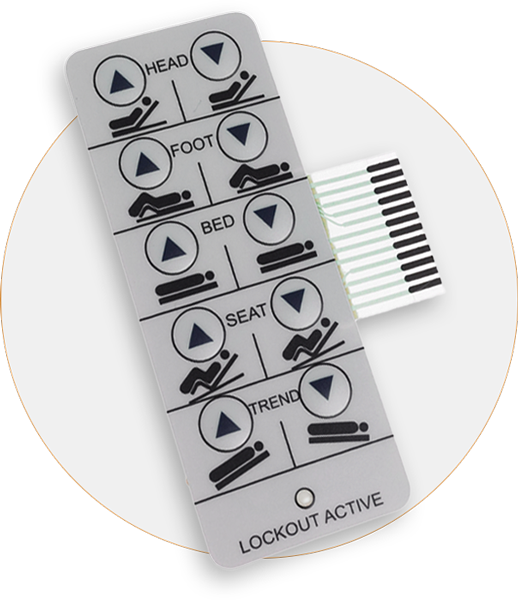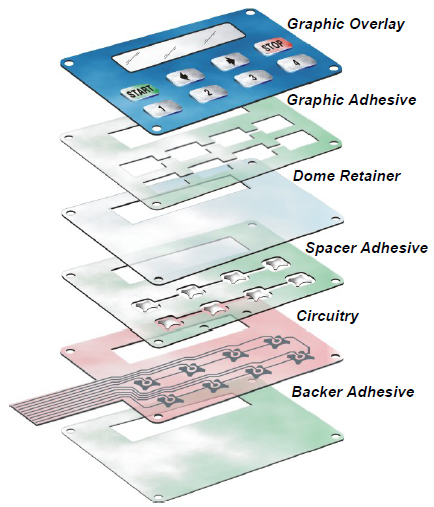When special application needs arise, a specialized membrane switch manufacturer is the best choice.
When special application needs arise, a specialized membrane switch manufacturer is the best choice.
Blog Article
All Regarding Membrane Change: Recognizing Its Design and Performance
When you believe about the control interfaces in modern-day tools, membrane layer buttons often come to mind. Let's explore what sets membrane switches apart from other control systems.
What Are Membrane Buttons?

Membrane buttons can likewise be customized relating to form, dimension, and graphics, permitting makers to produce unique user interfaces tailored to certain items. In general, membrane layer buttons play a substantial duty in boosting user experience throughout a large array of applications.
How Membrane Changes Job
When you push a key on a membrane layer button, it turns on an uncomplicated yet efficient mechanism. The leading layer, often made from adaptable material, lowers onto a conductive layer under it. This action bridges the gap between conductive traces, completing an electric circuit. As quickly as the circuit closes, it sends out a signal to the tool's controller, which translates your input.
You'll discover that the tactile comments differs based upon the switch style, offering either a soft click or a more noticable response. Once you release the secret, the membrane go back to its original placement, reopening the circuit and quiting the signal. This process takes place nearly immediately, making certain a receptive user experience.
Membrane layer switches are preferred because of their resilience and resistance to dirt and wetness, making them suitable for numerous applications, from household appliances to medical gadgets. Comprehending this procedure aids you value their prevalent usage.
Trick Components of Membrane Buttons
Understanding the vital parts of membrane layer switches is basic for understanding their capability and style. At the core, you'll find the graphic overlay, which provides the aesthetic user interface for customers. Under that, there's a spacer layer that divides the circuit layers, making sure that they do not make get in touch with until pushed. The circuit layer is where the magic takes place; it is composed of conductive traces that finish the circuit when you press the button. An additional crucial element is the glue support, allowing the button to stick to surface areas safely. The protective layer shields against environmental elements and wear, expanding the switch's life expectancy. Each part plays a substantial function in ensuring reputable efficiency and customer communication. By recognizing these components, you'll obtain understanding into how membrane changes run and their significance in different applications.
Products Made Use Of in Membrane Switch Layout
The efficiency and longevity of membrane switches over heavily rely on the products used in their design. You normally encounter polyester and polycarbonate as main substratums due to their superb stamina and flexibility. These materials resist scrapes and chemicals, making them suitable for requiring atmospheres.
The conductive layers typically make use of silver or carbon, picked for their integrity and conductivity. membrane switch manufacturer. Silver supplies superior performance, while carbon is an affordable alternative. For the overlay, you may take into consideration a matte or shiny finish, depending on your aesthetic needs and user experience
Adhesives play a crucial role too; they bond layers safely and assure durability. Ensure to choose adhesives that you can look here hold up against ecological variables like temperature and humidity. Finally, do not neglect the importance of a good printing technique for graphics, as it improves both functionality and visual appeal. Choosing the best products will certainly guarantee your membrane button stands the test of time.
Layout Considerations for Membrane Layer Buttons
While creating membrane layer buttons, it's vital to take into account different factors that influence their capability and user experience. Begin by focusing on the format and switch size; make particular they're intuitive and very easy to browse.
Do not overlook the graphic layout; browse around this site clear labeling and color comparison are significant for visibility. Validate your design accommodates ecological factors, like moisture or temperature variants, which can affect performance. Ultimately, bear in mind the value of screening models with actual users to collect responses and make needed modifications. This iterative process aids you improve the design, verifying it satisfies both useful and visual needs effectively. By very carefully considering these aspects, you'll create a membrane Continue switch that enhances use and fulfillment.
Applications of Membrane Layer Buttons
Membrane layer buttons are versatile elements found in various applications, from commercial tools to customer electronics. You'll see their influence in machines that require durable user interfaces and in gadgets that profit from sleek layouts. Recognizing these applications aids you value the performance and usefulness of membrane layer switches in everyday technology.
Industrial Tools Use
When you're looking to enhance the capability of industrial devices, membrane switches supply a trustworthy solution that combines sturdiness with straightforward style. These switches are excellent for harsh environments, providing resistance to dust, wetness, and chemicals. Accept membrane layer buttons to enhance your operations and boost total performance.
Consumer Electronics Combination
In the domain of consumer electronics, membrane switches play a crucial role in enhancing individual interaction and gadget functionality. Membrane layer switches likewise guarantee longevity and resistance to dirt and dampness, prolonging the life-span of your electronics. By selecting membrane switches, you enhance not simply the performance yet likewise the design of your devices, making daily interactions smooth and delightful.
Benefits and Negative Aspects of Membrane Layer Buttons
While membrane buttons provide an array of advantages, they additionally come with some disadvantages that you should take into consideration. One considerable advantage is their portable layout, making them excellent for space-constrained applications.

Nonetheless, there are disadvantages. Membrane layer switches can have a shorter life-span compared to mechanical switches, especially under heavy usage. They can likewise be much less tactile, which may influence individual comments during procedure. If harmed, fixing them can be tough and commonly requires total replacement. Inevitably, their sensitivity to severe temperatures and environmental conditions might restrict their effectiveness in certain setups. Stabilizing these advantages and disadvantages will help you establish if membrane buttons are the ideal fit for your task.
Often Asked Concerns
For How Long Do Membrane Layer Switches Over Commonly Last?
Membrane layer changes usually last in between 5 to one decade, depending upon use and environmental problems. You'll desire to review aspects like wear, direct exposure to dampness, and temperature level variations to determine their durability efficiently.
Can Membrane Switches Over Be Customized for Particular Layouts?
Yes, you can customize membrane switches to fit specific layouts (membrane switch manufacturer). You'll have the freedom to select colors, shapes, and formats that match your job's needs, ensuring they blend flawlessly with your overall aesthetic
What Is the Price Range for Membrane Change Production?
The cost array for membrane switch production commonly drops in between $1 and $10 each, depending on elements like style intricacy, amount, and products. You can obtain quotes from manufacturers to discover the very best alternative.

Are Membrane Layer Switches Waterproof or Resistant?
Membrane buttons can be created to be waterproof or resistant, depending upon materials used and building and construction techniques. If you require them for wet environments, guarantee you specify those needs during the layout process.
How Do Membrane Switches Over Compare to Standard Buttons?
Membrane layer buttons are usually thinner and more adaptable than traditional switches, supplying a smooth layout. They're frequently simpler to clean up and integrate, yet might not supply the responsive responses you're made use of to with mechanical options.
Verdict

Report this page